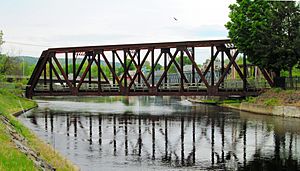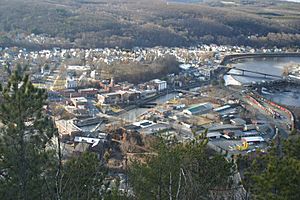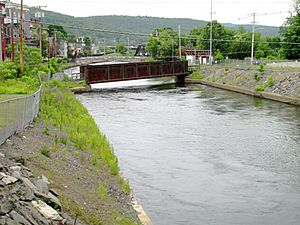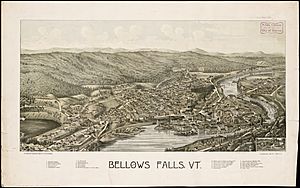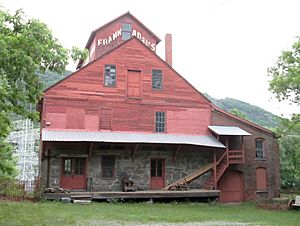Bellows Falls Canal facts for kids
The Bellows Falls Canal is a special waterway built in Bellows Falls, Vermont. It was made to help boats get around the powerful Great Falls on the Connecticut River. This canal was one of the first ever built in the United States!
It was created by the Bellows Falls Canal Company. The canal was used for different things over time. First, it helped transport goods by boat. Later, it powered factories (mills). Today, it helps create clean electricity. The canal is an important part of the Bellows Falls Downtown Historic District.
You can find a historical marker on Bridge Street in Bellows Falls that tells more about the canal's past. The Library of Congress even has an old photo of the canal from 1907.
History of the Canal
Building the Bellows Falls Canal was a big project. A company from Britain started the work in 1791. Their goal was to make the Connecticut River easier for boats to travel on.
It took 10 years to build the canal. Workers built nine locks and a dam. These structures helped boats go around the 52-foot (16-meter) high Great Falls. The canal was finally finished and opened in 1802.
From Boats to Mills
Even though the canal was built for boats, factories quickly started using its water power. By the time it opened in 1802, at least one mill was already using the canal. More mills were built soon after.
Boat traffic on the canal began to slow down after 1849. This was because trains (railroads) started coming to the area. Trains became a faster way to move goods. By 1858, boats no longer used the canal at all.
After 1858, the canal's main job was to provide water power to the nearby mills. There were six mills using its power at that time.
Powering the Future
Over time, the mills switched from water power to electric power. Because of this, the lower part of the canal, where the locks were, was filled in. This happened around 1926-1928.
The upper part of the canal was made wider. This allowed it to carry more water to a new hydroelectric plant. This plant was built on Bridge Street and became the new southern end of the canal.
The hydroelectric plant still works today. It even has a special fish ladder. This ladder helps fish, especially American shad, swim past the dam. There's a visitors center with a viewing window. You can often watch the fish swim up the ladder during the summer!
The Canal's Old Mill Area
The lower part of the canal, south of Bridge Street, was once full of mills. This area is now called Mill Street. An old map from 1886 shows many of these mills.
Today, only one of those original mills is still standing. It's called the Frank Adams Grist Mill. You can see it in old pictures, usually labeled with the number "13."
The area where these mills once stood is now a public park. It's called the Bellows Falls Historic Riverfront Park and Trail System. It's a great place to visit along Mill Street.


